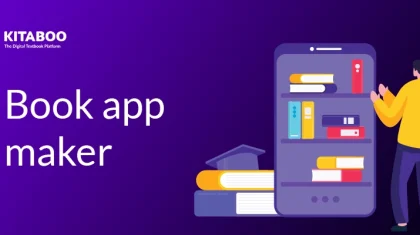
Why K12 Digital Textbooks Fail State Adoption—and How to Fix It
Summarize this blog with your favorite AI:
The K12 textbook market size has expanded enormously and is expected to reach $200.78 billion in 2025 from $161.88 billion in 2024. The trend of using affordable and accessible digital textbooks continues.
However, hundreds of K12 digital textbooks face state adoption challenges, often due to compliance, student engagement, or content-related issues.
In this regard, publishers need to understand complex state-specific requirements to ensure digital textbook adoption. This will help them align their content with state standards, secure funding eligibility, and enhance student engagement.
Read on as we explore the key barriers to K12 digital textbook adoption and explore actionable strategies for publishers to overcome them.
Table of Contents:
I. Why K12 Digital Textbooks Must Fit State Adoption Profiles
II. Key State Adoption Challenges Publishers Face
III. Strategies that Help Publishers Address State-Specific Requirements
- Seamless Integrations
- Accessibility Compliance
- AI-Based Tools
- Interactive Content
- Analytics and Reporting
IV. Proactive Steps that Publishers Can Take to Meet State-Specific Requirements
- Audit Curriculum Alignment
- Keep Abreast of Policy Changes
- Ensure Accessibility
- Add Analytics
- Maintain Educator Engagement
V. Wrapping Up
Why K12 Digital Textbooks Must Fit State Adoption Profiles
Presently, more states are setting tougher requirements, asking for more information or a different emphasis on certain topics. These rules are being modified frequently, so educational publishers struggle to meet the latest standards.
According to the Education Commission of the States, textbook adoption decisions are made at the state level in 19 states and Washington D.C., while in other states, local education agencies have the authority to select digital textbooks.
Colorado and Oklahoma have constitutional requirements surrounding textbook adoption. Tennessee, Rhode Island, and Nevada require the use of state-approved textbooks. However, Texas and New Mexico state that their adoption lists are mere recommendations, not requirements.
Let us look at the criteria that publishers need to consider:
State Adoption Criteria of K12 Digital Textbooks
A state adoption process guarantees the accuracy of adherence to most educational standards, along with accessibility and alignment to learning objectives.
Let us look at some of the basic requirements:
1. Curriculum Alignment
Digital textbooks must meet the state educational standards. Each state has a list of guidelines indicating what must be covered in every subject and grade level. A textbook that does not meet the state standards risks rejection, even if it is of good quality or with modern educational technology.
2. Funding Eligibility
Digital textbook adoption depends on meeting the funding criteria. Many school districts get the instructional material through government allocation. Digital textbooks that may not have been adopted could be ineligible for financial aid. K12 education for many states requires publishers to create digital textbooks that can:
- Reach a wider market of state-funded schools
- Reduce the cost the district is likely to incur while printing their digital texts
- Increase the reach of the distribution set across different states.
3. Teacher Confidence
States adopt materials for teachers to rely on high-quality, credible materials. Approved textbooks are more reliable and are implemented in classrooms as they are checked thoroughly. State adoption requires publishers to:
- Create pedagogically sound content based on research.
- Add materials that align with a lesson plan or assessment.
- Ensure content diversity, accuracy, and learning impact.
4. Student Success
Adopted digital textbooks are also designed to accommodate standardized assessments as well as long-term K12 educational achievement. An adopted textbook serves to:
- Reinforce key learning concepts necessary for progressing academically.
- Provide a fair access level to high-quality instructional materials.
- Ensure student readiness for higher studies and career-ready curriculum.
Key State Adoption Challenges Publishers Face
Despite the growing demand for digital learning materials, many publishers struggle to meet state adoption requirements, leading to rejection.
The most common challenges include:
1. Compliance
State departments of K12 education set strict criteria for textbook approval. Publishers must comply with specific learning standards, assessment requirements, and instructional guidelines. Challenges include diverging standards across different states and keeping the content updates accurate and relevant.
2. Student Engagement
For digital textbooks to be engaging for students, it must go beyond static text. Most publishers fail to create engaging multimedia content that supports their learning objectives. Some of the challenges are:
- Including multimedia enhancements such as videos, animations, and quizzes.
- Failing to implement adaptive learning pathways aligned with individual student needs.
- Adding gamification, simulations, and interactive elements that motivate students.
3. Accessibility
Ensuring that digital textbooks are accessible to all students with disabilities is one of the mandatory requirements for states to adopt the same. Common state adoption challenges include the following:
- Not conforming with WCAG 2.2 AA, ADA guidelines, or other legal compliance.
- No functionality for a screen reader and text-to-speech.
- Visual and audio elements not being accessible to people with disabilities.
In this regard, digital textbook platforms like KITABOO provide publishers with the necessary tools to ensure their content meets state accessibility standards.
4. Technical Integration
The learning institutions vary widely in their use of Learning Management Systems and Student Information Systems. If a digital textbook is incompatible with these, its adoption becomes difficult. Challenges include:
- Incompatibility with common LMS platforms.
- SSO problems for authentication.
- No support for interchanging data through the Learning Tools Interoperability standards.
5. Content Updates
Digital textbooks need to be updated so that they may match the change in K12 educational standards and policies. Publishers face several issues related to following updates in real time on various platforms.
Strategies that Help Publishers Address State-Specific Requirements
To overcome state adoption challenges, publishers must ensure that the following features align with the state-specific requirement:
1. Seamless Integrations
Digital textbooks need to interact with the already existing K12 educational ecosystem seamlessly. This enables effortless user authentication and role-based access in the form of SSO, SIS, LTI 1.3, etc. Publishers must ensure efficient data sharing across platforms for improved analytics and meet institutional security and interoperability standards.
2. Accessibility Compliance
Adoption by the state requires digital textbooks to be accessible to all students. The following are some measures for compliance with accessibility standards:
- Screen readers, text-to-speech, and alternative text descriptions.
- High-contrast visuals and captioned multimedia.
- Compliance with federal accessibility regulations, including the Americans with Disabilities Act.
3. AI-Based Tools
Artificial Intelligence supports digital textbooks through personalized learning experiences based on student progress. AI-based assessments need to be adaptive to students’ responses. Publishers must also focus on automated content recommendations to facilitate differentiated instruction.
4. Interactive Content
Publishers need to include interactive features in their K12 digital textbooks. These include:
- Gamified learning modules and knowledge checks.
- Interactivities that encourage students to be active participants.
- Simulations and real-world examples for experiential learning.
5. Analytics and Reporting
Data analysis can be a success indicator for adoption when tracking student performance to determine where the gaps are in learning. AI tools like predictive analytics help analyze the effectiveness of content usage. Moreover, adhering to feedback loops will help them update and refine content.
Proactive Steps that Publishers Can Take to Meet State-Specific Requirements
Publishers should be proactive when aligning digital textbooks to the state requirements. Here are some key strategies:
1. Audit Curriculum Alignment
Publishers must conduct regular content audits to ensure that all standards are covered. This helps them identify instructional material gaps and inconsistencies. Publishers can use feedback to adapt content according to state-specific learning objectives.
2. Keep Abreast of Policy Changes
Publishers must track updates in state K12 education policies and curriculum frameworks to remain compliant. They need to engage in policy discussions and industry conferences. Hence, making dynamic changes to digital textbook content can reflect new standards.
3. Ensure Accessibility
To meet state adoption, publishers must conduct accessibility auditing and usability testing periodically. They also need to include inclusive design for digital textbooks and train developers and content creators on the best practices regarding accessibility.
4. Add Analytics
Data analytics allows publishers to assess student engagement and measure the effectiveness of content. Using analytics, they can identify struggling students and adjust instructional strategies according to real-time performance metrics.
5. Maintain Educator Engagement
It is important to involve teachers in the content development process. This ensures practical insights into classroom needs and improvisation of teaching methods. Educators can offer valuable feedback for improving the structure and interactivity of lessons. Moreover, educators can increase adoption rates by promoting and endorsing the content.
Wrapping Up
Publishers need to maintain a more holistic approach to compliance, engagement, and accessibility to get K12 digital textbooks adopted in states. They must also improve the quality and appeal of digital textbooks according to specific state requirements.
Partnering with advanced digital textbook platforms like KITABOO can help publishers navigate these challenges effectively. It offers advanced tools for seamless integrations, accessibility compliance, interactive content, and real-time analytics—ensuring your digital textbooks meet state standards.
Ready to optimize your digital textbooks for state adoption? Request a demo today to explore how our platform can help you create engaging, compliant, and high-quality learning materials that align with state requirements!
Also Check:
Discover how a mobile-first training platform can help your organization.
KITABOO is a cloud-based platform to create, deliver & track mobile-first interactive training content.



